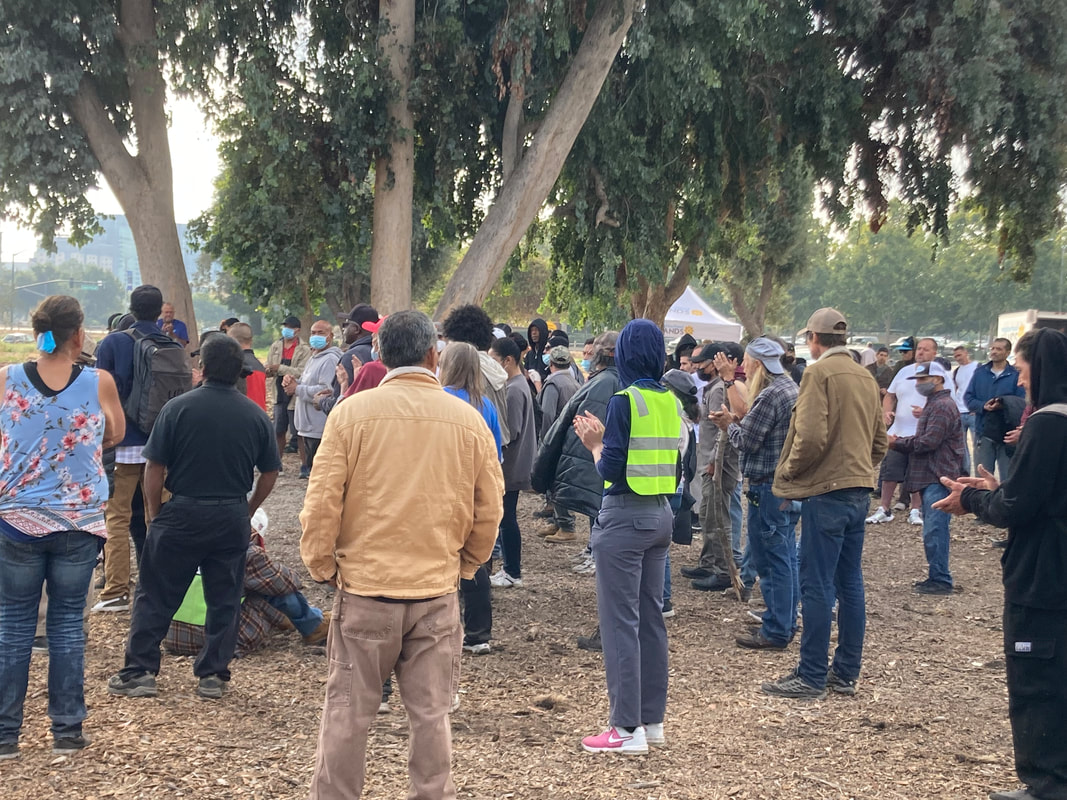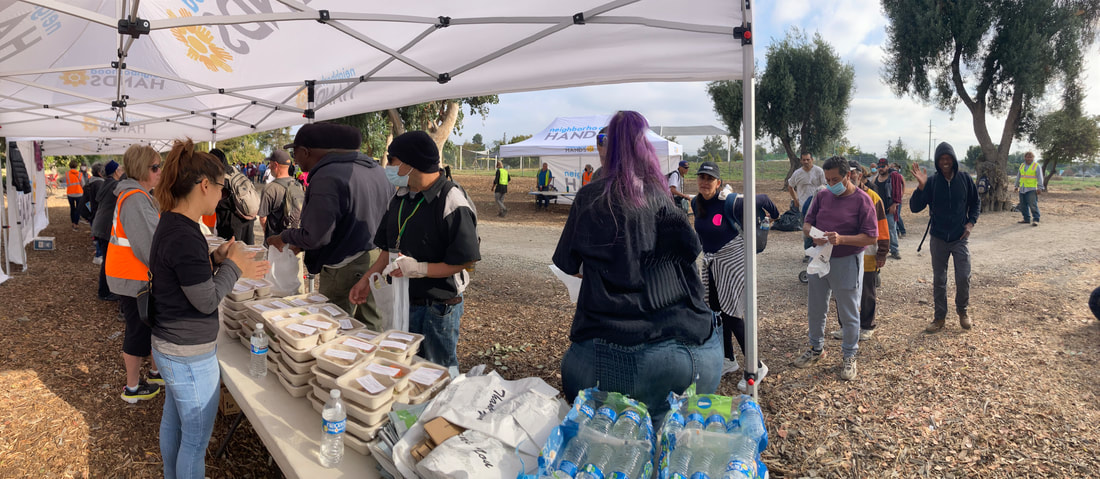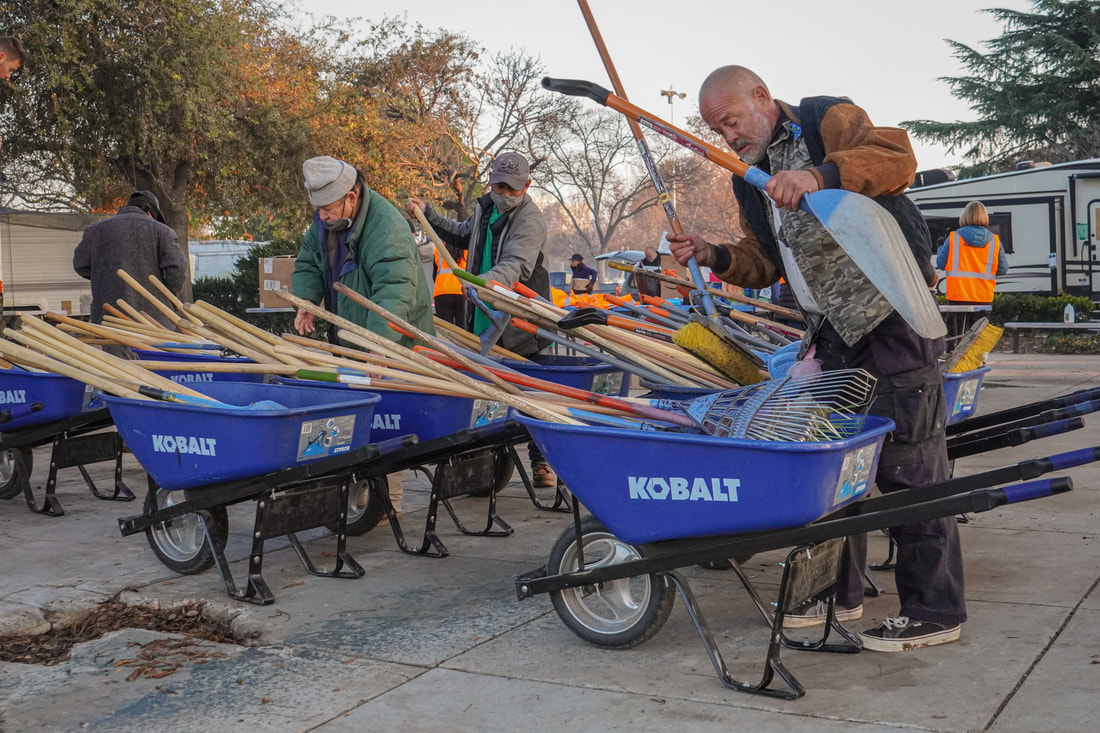Clients and Data
Primary Clients: Unhoused Residents, Homeless Service Providers, Public Parks
Through thousands of hours of listening, cleaning alongside our unhoused participants, and conducting research both locally and nationally, we understand our park-focused, community-based homeless outreach model to be a magnet for the following reasons.
#1: Our model meets unhoused neighbors where they are: physically, emotionally, and spiritually. By meeting highly at-risk and socially isolated individuals on their turf with an empowering, dignified, no-barrier opportunity to connect through a community-beautifying activity, we provide step one for unhoused neighbors to start their journey back to longer-term employment, housing, and stable living.
#2: Through a human-centered approach to program design, we prioritize the needs of unhoused residents based on their lived realities. This primarily entails listening first, removing bureaucratic barriers, and designing the program for convenience. Why is this important? Example: Many unhoused residents lack basic prerequisites for housing and employment: an address, phone number, ID, bank account. Going from unsheltered homelessness to a 40-year/week job simply isn't realistic for much of San Jose's unhoused population. This population needs an initial offering (or step one, as mentioned above) and highly efficient, comfortable, and immediate connection to the resources, services, and social capital of the neighborhood to get back on the path to self-sustainability.
#3: We provide a unique opportunity for inclusion for a population that often suffers from extreme social isolation. Humans are neurologically hard-wired for connection and need positive socialization to thrive. For this reason our model engages both unhoused and housed neighbors (our founder and board members clean alongside our unhoused participants every program) to take part in a dignified, community-serving activity in a made-for-fun space. This eliminates the awkward and often self-esteem crushing social dynamics that exist in many charitable service offerings, and breaks down very real social barriers that unhoused people experience while living on the streets.
January 2024 Survey Data from 102 Unhoused and Very Low-Income Participants:
Gender
#1: Our model meets unhoused neighbors where they are: physically, emotionally, and spiritually. By meeting highly at-risk and socially isolated individuals on their turf with an empowering, dignified, no-barrier opportunity to connect through a community-beautifying activity, we provide step one for unhoused neighbors to start their journey back to longer-term employment, housing, and stable living.
#2: Through a human-centered approach to program design, we prioritize the needs of unhoused residents based on their lived realities. This primarily entails listening first, removing bureaucratic barriers, and designing the program for convenience. Why is this important? Example: Many unhoused residents lack basic prerequisites for housing and employment: an address, phone number, ID, bank account. Going from unsheltered homelessness to a 40-year/week job simply isn't realistic for much of San Jose's unhoused population. This population needs an initial offering (or step one, as mentioned above) and highly efficient, comfortable, and immediate connection to the resources, services, and social capital of the neighborhood to get back on the path to self-sustainability.
#3: We provide a unique opportunity for inclusion for a population that often suffers from extreme social isolation. Humans are neurologically hard-wired for connection and need positive socialization to thrive. For this reason our model engages both unhoused and housed neighbors (our founder and board members clean alongside our unhoused participants every program) to take part in a dignified, community-serving activity in a made-for-fun space. This eliminates the awkward and often self-esteem crushing social dynamics that exist in many charitable service offerings, and breaks down very real social barriers that unhoused people experience while living on the streets.
January 2024 Survey Data from 102 Unhoused and Very Low-Income Participants:
Gender
- Male: 83%
- Female: 16%
- Prefer not to state: 1%
- 18 to 29: 4%
- 30 to 45: 32%
- 46 to 60: 40%
- 61+: 24%
- Latino/Hispanic: 66%
- Caucasian: 22%
- African American: 5%
- Asian: 3%
- Native American: 1%
- Mixed/Other: 3%
- Single - 75%
- Married/have a partner - 25%
- Yes - 8%
- No - 92%
- Shelter for unhoused: 22%
- Tent: 19%
- Completely unsheltered (outside): 18%
- Car/RV: 13%
- Temporary, non-stable housing (motel room, with a friend, etc.): 11%
- Tiny home: 2%
- House/apartment (not currently experiencing homelessness): 15%
- Yes - 79%
- No - 21%
- Loss of job - 41%
- Cost of housing/living so expensive - 13%
- Health condition - 8%
- Divorce/partner separation - 5%
- Personal or family crisis - 11%
- Substance use disorder - 4%
- Missing documents - 2%
- Mental health condition - 1%
- Domestic abuse - 1%
- Other - 14%
- Yes - 67%
- No - 33%
- No job - 46%
- Have a job but rent is too expensive - 9%
- Missing documents/IDs, etc. - 15%
- Lots of factors - 15%
- Legal issue/criminal history - 4%
- Health condition - 3%
- No money 2%
- No phone - 2%
- Not trying - 2%
- Long housing waitlist - 1%
- Addiction - 1%
- Food - 66%
- Transportation/gas - 12%
- Help family - 5%
- Clothing - 4%
- Drugs/alcohol - 4%
- Rent/shelter - 3%
- Tobacco/Cigarettes - 3%
- Hygiene - 2%
- Pet food - 1%
The Benefit for Homeless Service Providers: Highly Efficient Access to Unhoused Clients
Traditional homeless outreach methods which aim to reach the most highly at-risk individuals (those who are completely unsheltered) have a very tall order: approach potential clients on foot or vehicle and try to convince them to learn more about XYZ service offering, which usually exists miles away from the conversation being had. This method of outreach is not terribly helpful for unhoused residents -- whose lived realities are rarely conducive to traveling from A to B to C to Z to get the myriad services they need -- and is an inefficient allocation of limited resources, given the salaries involved with staffing such outreach.
By attracting large numbers of unhoused residents to a positive community environment at a predictable time, our model offers extremely efficient access for two key stakeholder groups -- homeless service providers and unhoused residents -- to connect in a comfortable space.
By attracting large numbers of unhoused residents to a positive community environment at a predictable time, our model offers extremely efficient access for two key stakeholder groups -- homeless service providers and unhoused residents -- to connect in a comfortable space.
The Benefit for Public Parks: A Community Solution to Funding Shortages
Significant reductions in funding for city parks have been a national trend since the Great Recession. With the exception of the one-time COVID stimulus, this trend has been exacerbated by the pandemic and disproportionately affects low-income neighborhoods and communities of color.
As a result, the City of San Jose’s Parks, Recreation, and Neighborhood Services Department has specifically highlighted community solutions in their ActivateSJ Strategic Plan (2020 - 2040) as a way to meet anticipated budget shortages over the coming decades. We believe Neighborhood Hands can be one of these community solutions.
As a result, the City of San Jose’s Parks, Recreation, and Neighborhood Services Department has specifically highlighted community solutions in their ActivateSJ Strategic Plan (2020 - 2040) as a way to meet anticipated budget shortages over the coming decades. We believe Neighborhood Hands can be one of these community solutions.
Additional Survey Data from Unhoused Participants:
- Resources, positive community, and "it feels good to clean the park" are the top three reasons unhoused residents attend our program.
- 44% are willing to travel one hour if our pilot program was relocated.
- 58% have attended our program more than ten times.
- 81% are willing to provide a testimonial about the impact our pilot program has had on their lives.



